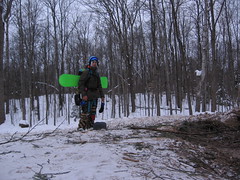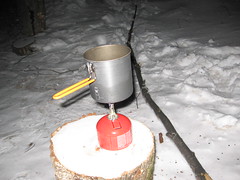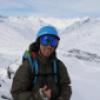“Not So Lost” In the Wild - testing new camping gear
I recently purchased some new camping equipment in anticipation of winter camping/snowboarding adventures this season. This past weekend, I decided that, in addition to going snowboarding, I would also take the opportunity to test out this new equipment in an area where, if something went wrong, I could easily make it back to "civilization" without freezing to death. The area in question: the woods around my home mountain of Mont Cascades. This experience promised to be, not only educational, but also convenient since I was planning to ride Mont Cascades on both Saturday and Sunday and not having to commute is a win!
 Snowboarding and winter camping seem like a logical pair. Here I'm all packed up and ready to head back to "civilization". I decided to document it "Survivor Man" style.
Snowboarding and winter camping seem like a logical pair. Here I'm all packed up and ready to head back to "civilization". I decided to document it "Survivor Man" style.My Saturday started out with a quick run to the Mountain Equipment Co-op to get some last minute supplies: safety matches, and snow stakes. With those in hand, I made my way to the ski hill to get my shred on. However, this weekend would prove to be extra special as my dad came out to learn how to snowboard. I had promised to teach him last year but then broke my knee cap &ndash which compelled him to back out rather than watch me man it up – but with my knee cap now intact, it was on. The only problem was that I'd be teaching basic freestyle to some 8-13 year-olds for two hours before hand, so I was a little concerned about breaking my dad (Hey dad! can you do a 360?).
In spite of my concerns, the lesson went off without a hitch. Although after about 45 minutes, my dad was complaining that his legs were sore (yup, that will happen). In that time, however, he managed to get off the chairlift twice without a major disaster, and do a controlled side slip down the beginner hill on both heel and toe sides (who says you can't teach old dogs new tricks?)
After the lesson and a quick cup of hot chocolate, I grabbed my pack and proceeded to get "not so lost" in the wild. It was about 7PM when I hiked into the bush, and the temperature was dropping fast. I found a good place to set up camp at the bottom of a new ski trail that was cut in the fall but not yet open to the public. As an added bonus, there was a fire pit there already – I guess they had been burning the trees they cut down – and the fire was still smoldering. So I stomped out a spot in the snow not too close to the fire pit and set myself to work setting up my tent.
After about an hour or so, my tent was set up. I anchored the base using deadman anchors (sticks burried in the snow), and staked the fly using my newly acquired snow stakes. I wasn't entirely convinced that the deadman anchors would work, but I suppose that's why I decided to do this test so that I wouldn't have to figure it out when I'm in the middle of nowhere (like Tuckerman Ravine for example).
 Two lessons here: 1) IsoPro doesn't burn well when it's cold, 2) snow occupies a lot more volume than water.
Two lessons here: 1) IsoPro doesn't burn well when it's cold, 2) snow occupies a lot more volume than water.Once camp was setup, it was time to make some food. I borrowed a camping stove and a cannister of IsoPro (an 80/20 blend of Isobutane and propane) from my cousin Mat. The Snowpeak stove was tiny and easy to set up, however, by the time I started it it was already approaching 9PM and the temperature was still dropping. My lighter wouldn't light in the cold, so I was glad that I brought safety matches. I had to re-light the stove several times; it seemed as though the IsoPro was getting pretty close to being liquefied by the cold.
Since I didn't carry any water in with me, I had to melt snow to get water to make food. For the next half hour, I went back and forth from a patch of fresh snow (untracked and un-yellowed) to the stove to refill the pot. It's amazing how little water there actually is in a litre of snow.
Once I was fed, I realized that I was alone in the woods, and had left my book back in the village. I wasn't really motivated to go back and get it, besides it was already after 9:30PM anyway, so I decided to do what I came here to do in the first place: test my down sleeping bag. So I stripped down to my base layer and slid into the sleeping bag. Because I wanted to test the warmth of the bag, I decided against using the ground mat so I could judge it in the most extreme circumstances possible (short of it being wet).
I woke up the next morning around 7:30. My face was a little cold since it was the only part of me that actually wasn't bundled up in down. So the sleeping bag was rather effective. However, I was not looking forward to getting out and into my cold clothes.
I decided to go the “quick rip of the band-aid” route and quickly jumped out of my sleeping bag into my outerwear. After about an hour, I was all packed up and ready to make my way back to the lift area of the ski hill. I was supposed to meet up with my friend Ryan to rip up some early morning groomers. I figured it was a good idea to plan to meet someone early in the morning anyway in case I had become a popsicle or cougar food at some point during the course of the night. Fortunately neither of those scenarios played themselves out. Here are a few things that I learned on this camping trip:
- IsoPro does not like being cold and does not burn well when it's liquid. To mitigate this, keep your camp fuel cannister inside your jacket for a while before trying to light your stove.
- Snow takes up a lot more volume than water. My guess is that it's about a 10:1 ratio.
- It's a good idea to keep your boot liners inside your sleeping bag overnight. This might not the most comfortable sleeping arrangement, however, it's a small price to pay for being able to feel your toes the next morning. I didn't start feeling mine until noon.
- Although deadman anchors don't seem very solid at first, just wait until you try and dig them up in the morning. They are a quite effective way of anchoring a tent, they just take a little time to set.
All in all, the camping gear test was a great success and I can't wait to get out again; it's a great way to connect with nature and avoid long commutes while getting rad. I was informed on Sunday that the temperature dropped to -20C overnight and I didn't even notice. This in spite of the fact that I didn't have a proper sleeping pad beneath me (my Big Agnes stayed in its sack). At this point, if I got a mummy liner for my sleeping bag, I'd probably be ready for just about anything short of an antarctic expedition. I even had time to take a few photos while I was at it, check them out on my flickr photo album.



